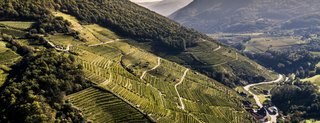
Bruck
Facts:
- Town:
- Viessling
- Size in ha:
- 17,38
- Altitude in m:
- 292 - 488
- Aspect:
- S - SW
- Average Slope in %:
- 37
- Max. Slope in %:
- 98
- Insolation in hours per year:
- 2017
- Terraced vineyard:
- Yes
- Distance to Danube in m:
- 2.835
- Labour required in h:
- 13.000
- First documentary evidence:
- MTF 1751 - 1753
Description
When speaking of famous wines from the Spitzer Graben, many automatically think of Riesling from the Bruck vineyard. Vines are cultivated on the narrow terraces at elevations of up to 480 metres above sea level.
Soil Profile Bruck
The acidic Spitzer granodiorite gneiss of the Bruck vineyard in the western Wachau represents the counterpart to the Gföhl gneiss in the east. It is often associated with dark-coloured, basic amphibolite. Since the soils contain practically no loess or carbonates, the pH is neutral to weakly acidic.
The sandy soil developed through the weathering of Spitz granodiorite gneiss and amphibolite. Both rock types contribute to the the high stone content (coarse soil). Through relocation processes on the slopes, the material finally came to rest on Spitz granodiorite gneiss. The weathered gneiss is interspersed with a quartz- and feldspar-rich subvolcanic rock, an aplite.




